People
‘I’m Like a Hoarder’: Takashi Murakami on His Impulsive Collecting Style, and Why He Still Believes in the Power of NFTs
The Japanese art star sat down with Artnet News on the occasion of his first show with Gagosian in France.
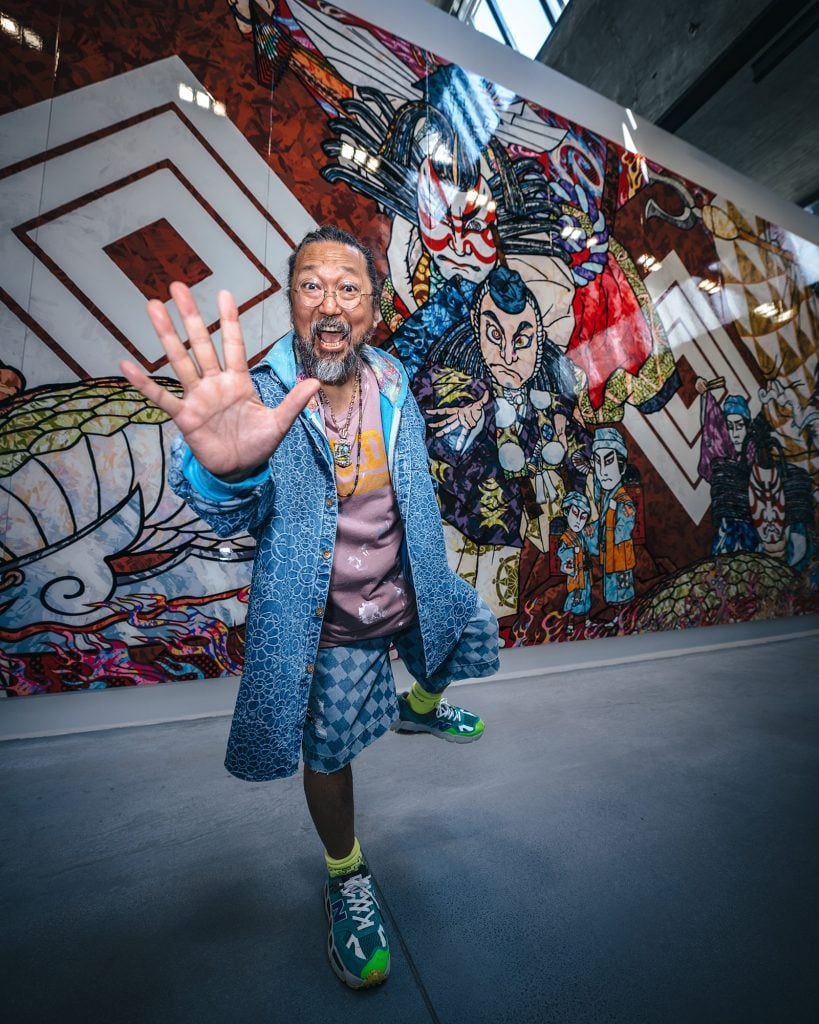
The Japanese art star sat down with Artnet News on the occasion of his first show with Gagosian in France.

Anna Sansom

When the Covid-19 pandemic started in early 2020, Takashi Murakami noticed how his 12-year-old son and nine-year-old daughter, who had no school, were constantly playing video and online games.
“I was very struck by how they were communicating with their friends through video games and I realized that gaming will be the most profound culture for this generation,” said the 61-year-old Japanese artist at the preview of his exhibition “Understanding the New Cognitive Domain” at Gagosian Le Bourget, located at an airport for private jets near Paris. The exhibition of five large-scale artworks and sculptures˙the latter of which comment on NFTs and the metaversal game space—is his first with the gallery in France. “I also felt I was doing the same thing all the time [in my art]; I was getting bored and wanted to refresh myself.”
NFTs and the gaming metaverse represent the new cognitive domain for Murakami. He recalls feeling similarly when failing to initially understand minimalism when he lived in New York in the mid-1990s and the steep learning curve it required. “When I first saw minimal art paintings, I was really confused,” he recollected. “Then I read into minimal art and, once I understood it, I suddenly thought the paintings were amazing.” Now, he hopes that, along these same lines, people will have a positive experience of NFTs and gaming.
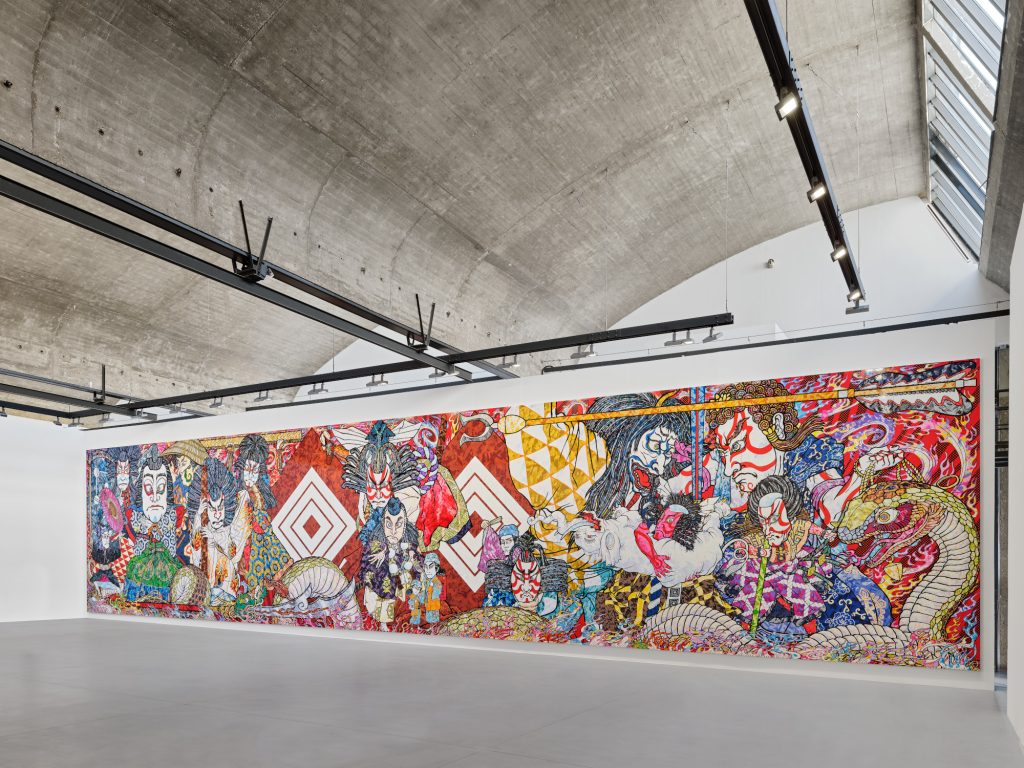
“Understanding the New Cognitive Domain,” 2023, installation view. ©️ 2023 Takashi Murakami/Kaikai Kiki Co., Ltd. All Rights Reserved. Photo: Thomas Lannes Courtesy Gagosian
Murakami began making NFTs after being impressed by Beeple’s NFT-based work of The First 5000 Days, which sold for over $69 million at Christie’s in May 2021. RTFKT, a Nike-acquired studio of virtual sneakers and collectibles, approached him to collaborate in 2021. Since then, Murakami has designed around 3,000 NFTs and a “Lucky Cat Coin Bank” on OpenSea.
The economic and discursive environment around crypto has changed significantly in the past year. “Things aren’t going well with NFT art and the crypto space so my involvement may seem stupid,” said Murakami, wearing a blue shirt printed with his smiling flowers and two necklaces with rainbow-hued pendants in a similar motif. “But I really believe this is another new cognitive domain that’ll be recognized in the near future. Even though there’s no substantive matter that you’re collecting, you still derive satisfaction and are exchanging things visually in the game.”
He insisted that it was “imperative” for him to enter gaming for the survival of his art production company, Kaikai Kiki, which has offices in Tokyo and Brooklyn. The company faced bankruptcy in 2020. “I’m trying to turn it into an online gaming company, so I’m hoping to work with someone who can make that project happen, although Japanese law still makes using cryptocurrency pretty difficult,” Murakami said.
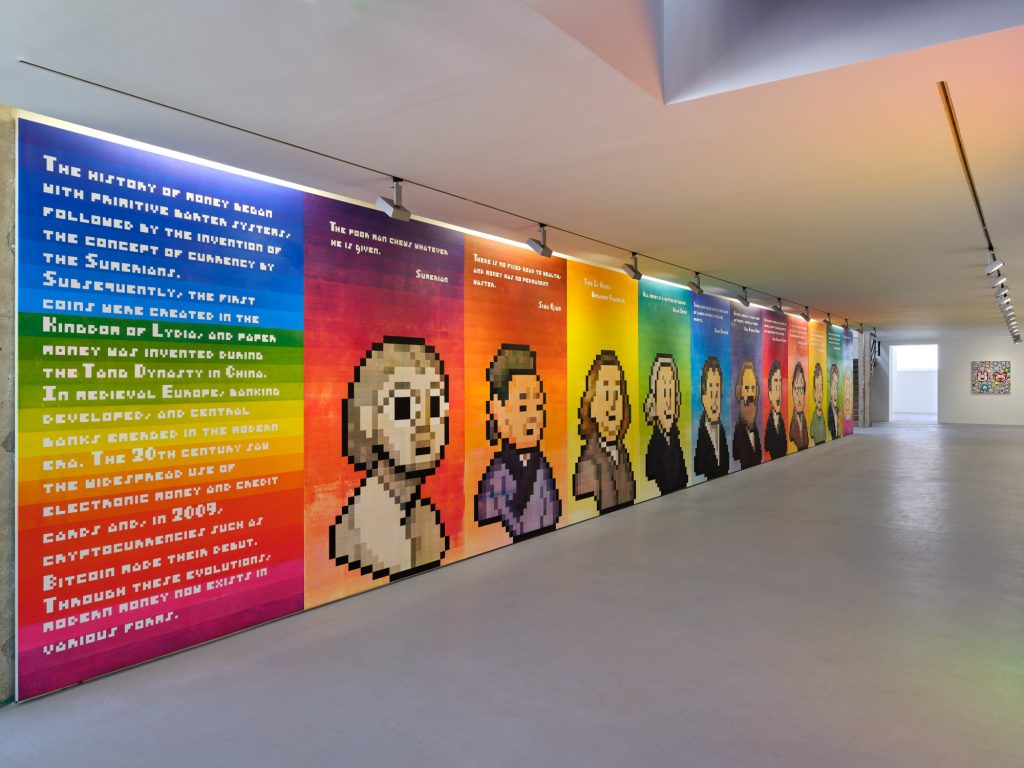
“Understanding the New Cognitive Domain,” 2023, installation view. ©️ 2023 Takashi Murakami/Kaikai Kiki Co., Ltd. All Rights Reserved. Photo: Thomas Lannes Courtesy Gagosian
Despite the more somber mood around crypto, he managed to generate some excitement in France: at his exhibition opening on the outskirts of Paris at Gagosian, attended by singer/songwriter and Louis Vuitton men’s creative director Pharrell Williams (who formerly collaborated with Murakami on a sculpture), Murakami gave away a Flower Jet Coin NFT to every visitor. Several pixelated paintings in the show, running through December 22, 2023, are reminiscent of the Lucky Cat NFTs, encapsulating a back-and-forth between the virtual and physical worlds.
Born in Tokyo, Murakami felt inspired to become an artist after watching the manga animation movie Galaxy Express 999. He has a PhD in Nihonga Japanese painting and blended this classical training with a manga-infused aesthetic, spearheading Japan’s contemporary art scene.
In 2000, he invented his Superflat manifesto, a postmodern concept referring to formal aspects of Japanese art, such as flatness of the picture plane, as well as a rejection of hierarchical divisions between genres. Having taught students applying to university how to draw flowers, he reinterpreted the traditional flower motif in Nihonga art in his work. The sinister undertone to his trademark smiling flowers alludes to the trauma of Japan post-World War 2 in the aftermath of the Hiroshima and Nagasaki atomic bombs.
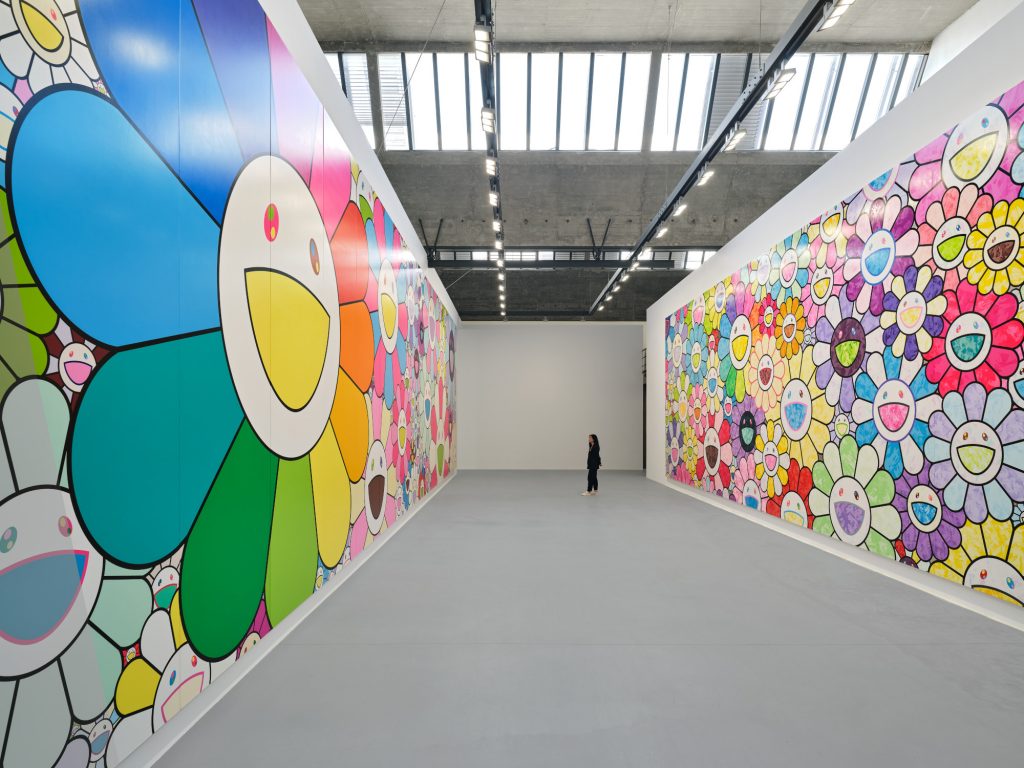
“Understanding the New Cognitive Domain,” 2023, installation view. ©️ 2023 Takashi Murakami/Kaikai Kiki Co., Ltd. All Rights Reserved. Photo: Thomas Lannes Courtesy Gagosian
Grasping Superflat is key to comprehending Murakami’s art. “If people understand or recognize Superflat as a new domain, they’ll understand my own artwork as well,” affirmed Murakami, who had a solo show at the Château de Versailles in 2010. “When I first said Superflat, it was just a catchphrase. But when I look back, it was my roadmap that enables me to delve into NFT art, gaming and subculture without any sort of reserve even though I’m old.”
On view at Gagosian are several paintings exemplifying Murakami’s Superflat vision. The standout is an enormous, 5-by-23-meter painting (16 by 75 feet) based on the stage curtain that Murakami produced for the Kabukiza Theater in Tokyo in November. The curtain was made for the ceremony of Kabuki actor and producer Ichikawa Ebizō XI succeeding to the highly prestigious stage name Ichikawa Danjūrō XIII, Hakuen, which is passed down through the Ichikawa family’s 350-year-old history, making him heir of the Naritaya guild. “When I saw the curtain in the theatre, I thought it wasn’t big enough and really wanted to make a large-scale painting,” Murakami explained.
The ensuing, highly detailed painting, 2020 The Name Succession of Ichikawa Danjūrō XIII, Hakuen, Kabuki Jūhachiban (2023), draws on 18 kabuki plays from the last three centuries. Capturing intense expressions and elaborate makeup and costumes, the figurative drama is accentuated by red-and-white diamonds. “I used to paint the motifs of post-Second World War Japan, but these motifs have survived from long before that, from the Edo and Meiji periods, and are still alive in Japanese culture,” enthused Murakami.
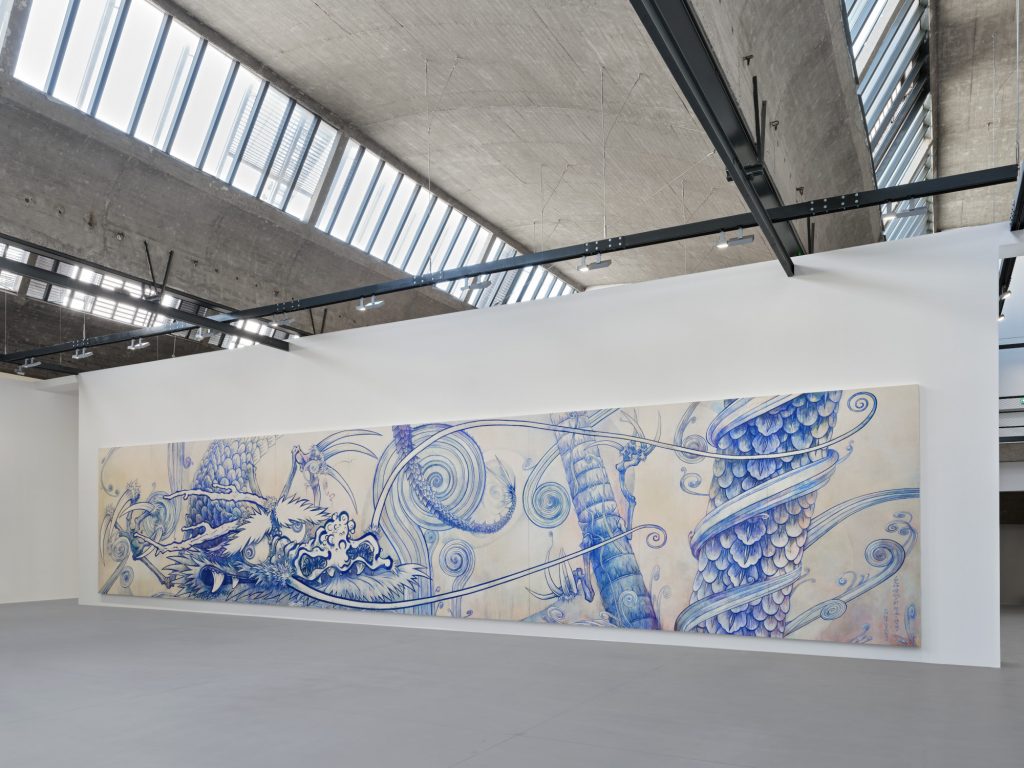
“Understanding the New Cognitive Domain,” 2023, installation view. ©️ 2023 Takashi Murakami/Kaikai Kiki Co., Ltd. All Rights Reserved. Photo: Thomas Lannes Courtesy Gagosian
On the opposite wall is Dragon in Clouds – Indigo Blue (2010). It is inspired by eccentric Japanese artist Soga Shōhaku’s eight-panel-work Dragon and Clouds (1763) of a dragon swooping down and lashing its scaly tail through whirls of clouds. Murakami’s revisitation, with the dragon’s bulging eyes and flared nostrils amid turbulent, swirling shapes, evinces how he seeks to position himself within the lineage of Japanese art. “Even though people think it’s figurative, it’s about engaging the viewer’s eye by employing the method of abstract painting,” added Murakami.
Also on show is a work based on Mike Kelley’s Pay for Your Pleasure (1988) that replaces Kelley’s subjects with a timeline of important economists, such as Sima Qian and Benjamin Franklin; alongside them is business tycoon Elon Musk and the cryptocurrency Dogecoin.
Besides being the figurehead of Japan’s contemporary art scene, Murakami owns Kaikai Kiki Gallery, which represents ten other Japanese artists such as Aya Takano and Otani Workshop. He also founded Geisai, a fair for emerging artists under the age of 30, in 2002. After an eight-year-long hiatus, he reignited Geisai in August 2022. Murakami complained on Instagram that artists who had previously debuted through Geisai “were often disgusted with me and behaved in terrible manners” to explain why he had paused the event.
“Setting aside the emotion and disappointment that I felt, I’m convinced that Kaikai Kiki and Geisai’s influence and what we’ve done has come to fruition because there are many artists producing manga-like aesthetic artwork,” Murakami said. “It’s still proliferating the market which proves that Geisai wasn’t wasted.” The last edition of Geisai took place in April alongside the launch of a new event, Geisai Classic, for artists aged 30 and over in response to criticism from older artists who felt excluded from Geisai. The dates of next year’s event are yet to be confirmed.
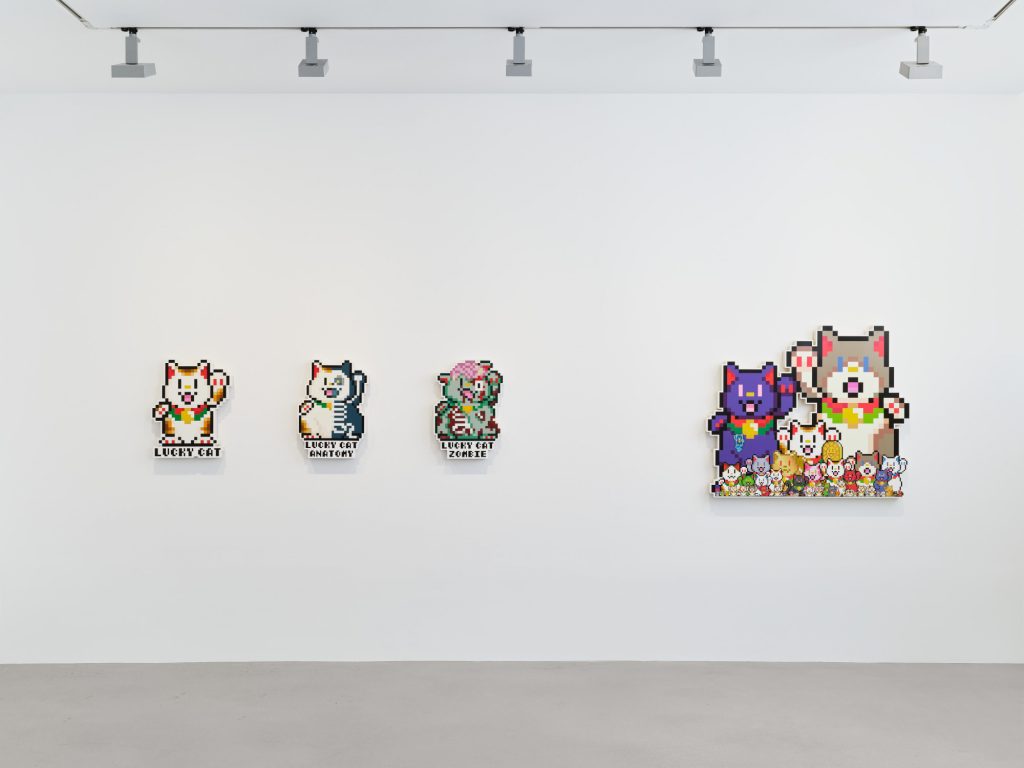
“Understanding the New Cognitive Domain,” 2023, installation view. ©️ 2023 Takashi Murakami/Kaikai Kiki Co., Ltd. All Rights Reserved. Photo: Thomas Lannes Courtesy Gagosian
Murakami is also an avid collector. He began collecting the evening when My Lonesome Cowboy (1998), his nude sculpture of a blonde-haired boy creating a lasso with his own sperm, sold for over $15 million at Sotheby’s in 2008. After it went under the hammer, Murakami acquired an artwork by fellow Japanese artist Yoshitomo Nara in the same sale.
“I lost sense of the value of my work so I wanted to learn by using all the money I had to buy works less expensive than my own, so that I could experience a collection from the collector’s side,” Murakami recounted. “When I find something really attractive, I want to see how much I’m willing to pay for it and I keep bidding until then.”
Today, the thousands of artworks in Murakami’s collection are stored in six rented warehouses and four galleries in Tokyo. An exhibition at Japan’s Yokohama Museum of Art in 2016 revealed its mind-boggling breadth, from Japanese and Asian artifacts to Edo-era paintings, European antiques, ceramics by Kitaōji Rosanjin, and contemporary art by the likes of Anselm Kiefer.
“It was daunting to realize how huge my collection was,” Murakami admitted. “And I felt that there was some Asperger-type tendency in the way I collected. I’m kind of like a hoarder, I can’t throw things away. I collect impulsively.”
Murakami’s obsessive collecting has helped improve his reputation in some quarters in Japan where he is “still not well received” by society. “But in the antique industry, maybe because I’m spending so much money, I’m not quite so despised any more,” he said.
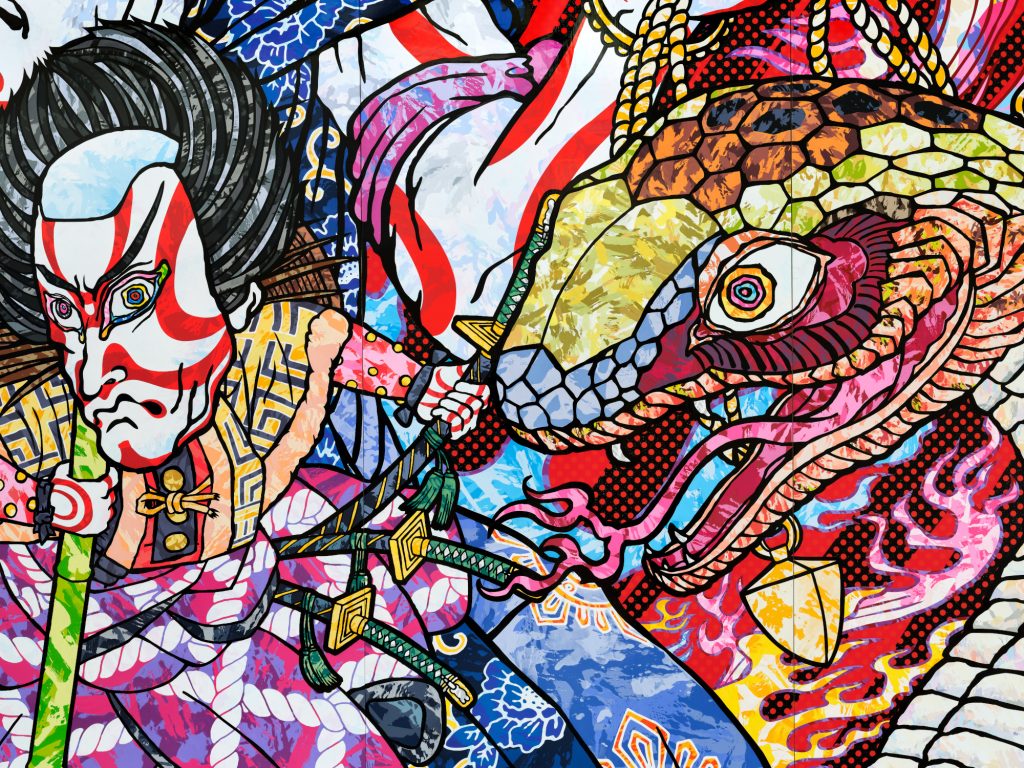
2020 The Name Succession of Ichikawa Danjūrō XIII, Hakuen, Kabuki Jūhachiban (2023) ©️ 2023 Takashi Murakami/Kaikai Kiki Co., Ltd. All Rights Reserved. Photo: Thomas Lannes Courtesy Gagosian
Asked about his thoughts on legacy, Murakami replied: “When I started my collection, I was thinking of creating a foundation. But the Japanese tax system makes it pretty difficult to pass things onto the next generation. So I might have to sell everything, which is very sad but a reality, or pay a huge, multi-million dollar tax bill which is impossible. Originally, I battled capitalism but now I battle tax,” he added, laughing.
Despite his struggles, Murakami ardently believes in the power that art can have on society. Indeed, his desire is to emulate the 16th century tea master Sen Rikyū who perfected the tea ceremony, raising it to the level of art.
“For Sen Rikyū, art was used to build the nation and it became the muscle and bone of the nation being constructed at the time,” Murakami said. “You don’t see that so much these days. But I really think art can still be the core and foundation for a nation, which is why I’m still very much involved.”
On an optimistic note, Murakami—who marvelled on Instagram at the phenomenon of cherry blossoms upon his return from Art Basel Hong Kong in March— concluded: “In my head, everything is fresh, everything is beautiful, everywhere is perfect in my paintings and sculptures.”
“Understanding the New Cognitive Domain” is on view until December 22, 2023 at Gagosian Le Bourget